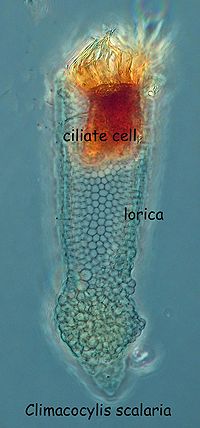
Choreotrich
Encyclopedia
The choreotrichs are a group of small, marine ciliate
s. Their name reflects the impression that they appear to dance ('choreo' as in choreography). The group includes the tintinnid
s, which produce species-specific loricae
(shells), and are important because these may be preserved as microfossils. They became common during the Jurassic
period, but are first known from as early as the Ordovician
, and are important as the only notable record of early ciliates. Often they have been included among the oligotrich
s. Tintinnids seem to be an excessively specious group as over 400 living species have been described, based on characteristics of the lorica or shell.
Choreotrichs (including tintinnids) are part of the microzooplankton. Generally small (20 - 200 micrometres in size) organisms found in the plankton. They feed on small algae and serve as prey for larger organisms in the plankton such as copepods and larval fish.

Ciliate
The ciliates are a group of protozoans characterized by the presence of hair-like organelles called cilia, which are identical in structure to flagella but typically shorter and present in much larger numbers with a different undulating pattern than flagella...
s. Their name reflects the impression that they appear to dance ('choreo' as in choreography). The group includes the tintinnid
Tintinnid
Tintinnids are ciliates of the choreotrich taxon Tintinnida, distinguished by vase-shaped shells called loricae, which are mostly protein but may incorporate minute pieces of minerals. Although appearing as early as the Ordovician period, tintinnids became abundant in the fossil record during the...
s, which produce species-specific loricae
Lorica (biology)
In biology, a lorica is a shell-like protective outer covering, often reinforced with sand grains and other particles that some protozoans and loricifera metazoans secrete. Usually it is tubular or conical in shape, with a loose case that is closed at one end. An example is the protozoan genus...
(shells), and are important because these may be preserved as microfossils. They became common during the Jurassic
Jurassic
The Jurassic is a geologic period and system that extends from about Mya to Mya, that is, from the end of the Triassic to the beginning of the Cretaceous. The Jurassic constitutes the middle period of the Mesozoic era, also known as the age of reptiles. The start of the period is marked by...
period, but are first known from as early as the Ordovician
Ordovician
The Ordovician is a geologic period and system, the second of six of the Paleozoic Era, and covers the time between 488.3±1.7 to 443.7±1.5 million years ago . It follows the Cambrian Period and is followed by the Silurian Period...
, and are important as the only notable record of early ciliates. Often they have been included among the oligotrich
Oligotrich
The oligotrichs are a group of ciliate protozoa, included among the spirotrichs. They have prominent oral cilia, which are arranged as a collar and lapel, in contrast to the choreotrichs where they form a complete circle. The body cilia are reduced to a girdle and ventral cilia...
s. Tintinnids seem to be an excessively specious group as over 400 living species have been described, based on characteristics of the lorica or shell.
Choreotrichs (including tintinnids) are part of the microzooplankton. Generally small (20 - 200 micrometres in size) organisms found in the plankton. They feed on small algae and serve as prey for larger organisms in the plankton such as copepods and larval fish.


